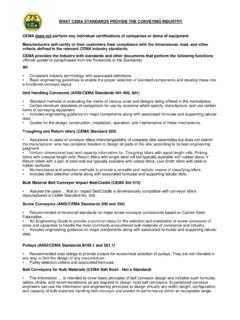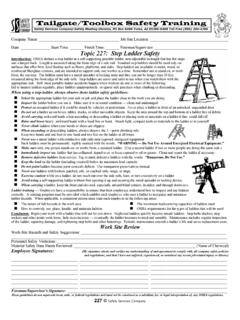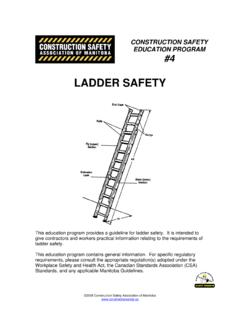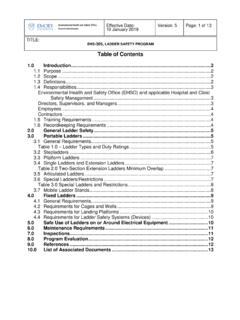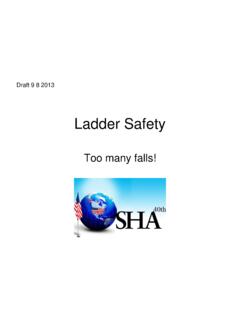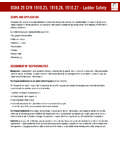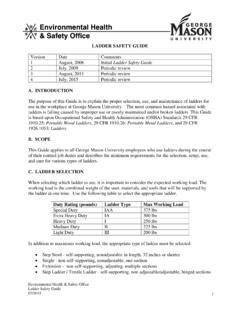Transcription of Deisgn and Safe Application of Conveyor Crossovers for ...
1 Conveyor Equipment Manufacturers Association (CEMA) Safety Best Practices Recommendation CEMA SBP-001 (2004) Design and safe Application of Conveyor Crossovers for Unit Handling Conveyors Provided as a service to the Conveying Industry by the CEMA Engineering ConferenceOriginal Publication Date: June 1, 2004 Change 1: November 17, 2004 i. TABLE OF CONTENTS A. PURPOSE STATEMENT B. DEFINITIONS C. HUMAN FACTOR CONSIDERATIONS D. GENERAL DESIGN PARAMETERS Crossovers AT Conveyor HEIGHT Crossovers ABOVE THE Conveyor E. Application GENERAL Application GUIDE (CHART) F. MECHANICAL SAFETY CONSIDERATIONS G. CONTROLS H. ADDITIONAL CONFIGURATIONS DISCLAIMER These considerations are advisory only. CEMA makes no warranties (express, implied or statutory) in connection with these considerations. Users of the considerations specifically understand and agree that CEMA, its member companies, its officers, agents and employees shall not be liable in tort or contract - whether based on warranty, negligence, strict liability, or any other theory of liability - for any action or failure to act in respect to the design, erection, installation, manufacture, preparation for sale, characteristics, features of delivery of anything derived from, or covered by these consideration.
2 By employing or otherwise referring to these considerations, it is the user s intent and understanding to absolve and protect CEMA, its member companies, its successors, assigns, officers, agents and employees from any and all tort, contract or other liability. Conveyor EQUIPMENT MANUFACTURERS ASSOCIATION 6724 Lone Oak Blvd Naples, Florida 34109 Web Site: CEMA Safety Best Practices Recommendation (SBP) No. 001-2004 - Copyright 2004ii. CHANGE RECORD Original Publication Date: June 1. 2004 Change 1: November 17, 2004 In response to many inquiries, we added the citation in the California Code of Regulations that CALOSHA uses to limit the types of allowable Crossovers to the note at the bottom of page 6 to allow people to find the 1, 2004 CEMA SBP 001-2004 1. Design and safe Application of Conveyor Crossovers for Unit Handling Conveyors A. PURPOSE The purpose of this document is to outline a standardized approach to the devices and items routinely provided to allow personnel to cross unit handling material handling conveyors used in a typical warehouse or manufacturing facility.
3 These approaches flow from the collective experience of the member companies of the Unit Handling Section of the Conveyor Equipment Manufactures Association (CEMA). They have been collected herein in to offer considerations for selection and use of Crossovers as one means of creating a safer operating environment for people working with unit handling Conveyor systems. Specific conditions will vary from Application to Application , as will the purposes and experience level of the personnel expected to use the Crossovers . These varying conditions, purposes, and experience levels will affect the selection of the type and design of the equipment provided in any given situation. The interests of practicality, utility, and safety are of prime concern in evaluating any proposed design. B. DEFINITIONS The definitions of terms used within this standard will conform to those identified in CEMA Standard #102 Conveyor Terms and Definitions , except as re-defined within this section.
4 Additional terms not currently found in CEMA 102 are be defined here. Conveyor crossover - A device used to allow personnel to cross conveyors at designated and approved locations. Fill in Plates - Closely fitted plates positioned between the rollers, wheels or chains of powered or non-powered conveyors. These plates may be intended to be used as portions of a walk way, to provide a steadying / resting place, and or to prevent access to potential injury producing catch points. ladder crossover - A Conveyor crossing device consisting of one or more ladders with support railings and, possibly, a platform that traverses the Conveyor path. (See types 1 & 3) June 1, 2004 CEMA SBP 001-2004 - A step or platform intended to allow someone to stand at that location while resting or waiting for a passage way to clear. Ship s Stair - A stairway equipped with treads and stair rails with a slope of 50 to 70 degrees.
5 It is sometimes referred to as a ship s ladder . Stair crossover - A Conveyor crossing device, with a slope of less than 50 degrees, consisting of one or more stair step assemblies which may be joined together across the conveying surface by railings or railings and a platform or walkway. (Type 2 and 4) Step to Step Distance - The distance between two steps measured from trailing edge of the departure step to the leading edge of the arrival step. Stile - A generic term used to denote any crossing or passing device, sometimes used to denote a Conveyor crossover . C. HUMAN FACTOR CONSIDERATIONS People and their observed tendencies are the reason that CEMA has found it necessary to address the need for Crossovers . In operations areas where personnel are familiar with the conveying equipment, and their duties or routes of travel can require movement across Conveyor paths, there is a great potential for abuse of the most basic safety rules.
6 Temptations for these personnel to cross running and/or temporarily stopped conveyors are very strong. Experience has shown that accidents are inevitable under these conditions. Continuous analysis of worker requirements for movement and access in the Conveyor operating areas is necessary. Proper Application of Crossovers at the most needed locations can go a long way towards promoting workplace safety when conditions would otherwise present the temptation to cross the conveyors in an unsafe manner. D. GENERAL DESIGN PARAMETERS There are two different types of elevated Conveyor Crossovers commonly used in industrial applications . These are the ladder and stair types. Each of these can be sub categorized by whether they allow crossing at Conveyor height, or provide for crossing at an elevation which clears both the conveying surface and the highest item expected to be conveyed.
7 All four designs should be lagged to the floor for safety and stability. When designing these Crossovers , reference should be made, among others, to the following documents: ANSI Standard - Safety Requirements for Workplace Floor and Wall Openings, Stairs and Railing Systems OSHA s 29 CFR Part - Fixed Industrial Stairs OSHA s 29 CFR Part 29 CFR Part - Fixed Ladders June 1, 2004 CEMA SBP 001-2004 3. Crossovers AT Conveyor HEIGHT ladder - At conveying height (Type 1 Access Method) This crossover typically uses vertical ladders on both sides of the Conveyor , and hand rails (without middle rail) traversing the Conveyor . An angled ships ladder may also be used. This type requires the least floor and over the Conveyor space. It is also the easiest to install. The use of both hands is required while climbing the ladder and while crossing the Conveyor . This type of crossover is typically used by trained personnel for access to maintenance and for other operational purposes.
8 Stair - At Conveyor height (Type 2 Access Method) This type of stair crossover brings the walking surface height only up to the conveying surface height, or slightly above. There are routinely hand rails on one or both sides of both the stairs and the Conveyor crossing area. The crossing area will usually not have an intermediate rail, allowing for clearance for the conveyable to pass under the hand rail. This type of stair crossover improves on the vertical space requirements of the Type 3 (see below), but may not meet fire code egress requirements in all areas. These units can be applied in lower ceiling heights and head clearance areas than is possible with full decked Crossovers . They are easier to build and apply, and can be more easily moved when there are changes in Conveyor or personnel travel paths. This is the most convenient type of crossover to use, since often a package can easily be carried in one hand, and there are few steps to negotiate.
9 Personnel should be cautioned to cross only when conveyables are not present or immediately approaching on the Conveyor . This is not unlike crossing the street or fork truck aisle, except the traffic is much slower, comes from only one direction, and the pedestrian has one or more hand rails available the entire way across. In some instances, there will be no opportunity to step on the Conveyor surface. In these instances it will be necessary to step completely across the Conveyor . On the wider (and some narrow) applications , surfaces suitable for walking or stepping will be provided. On a wide belt or slat Conveyor , this will be accomplished by stopping the Conveyor during passage and using the conveying surface itself as a walkway if necessary. In these instances, the control of the Conveyor motion must be at the location of the passage. Those controls should be operated only by the person seeking passage.
10 June 1, 2004 CEMA SBP 001-2004 4. Crossovers ABOVE THE Conveyor ladder - Over the conveyable (Type 3 Access Method) The most elaborate type of ladder crossover clears both the Conveyor and the conveyable. This type has a ship s ladder (shown on the drawing) supporting both sides of a standard deck, with standard toe boards and railings. The ladders may be straight or angled as shown. If angled, there should also be hand rails on each side of the ladder for increased stability. These Crossovers save floor space over the stair type unit, while retaining the over the load capability. The disadvantages of this type of crossover are the same as with the stair Type 4 (see below), except that ladders require both hands to use safely. Both take up a lot of vertical space to provide both adequate package clearance with the crossover deck, and head clearance with the building or other structure.


